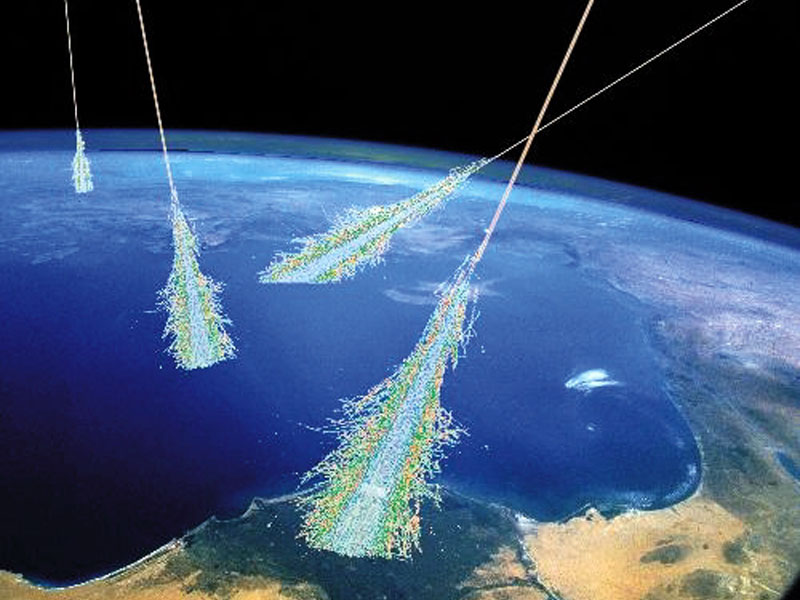Faster-than-light neutrinos come down to earth


Our recent stories about the neutrinos that travelled from CERN’s Geneva lab to Rome faster than the speed of light have struck a popular chord, so I thought I’d update you with the latest explanation.
CERN probably goofed.
So postulates Frank Close, professor of theoretical physics at Oxford University.Writing in the Guardian newspaper, he notes, “the only thing that travels faster than light is a rumor.”
Professor Close has credentials. He wrote the book Neutrino, so he would seem to know the tendencies of the shadowy subatomic particles that move unobstructed through earth. (That’s how CERN was able to beam them to Italy’s Gran Sasso lab 75 miles northeast of the Italian capital – it sent them ploughing under the Alps).
CERN wasn’t trying to set any speed records. It was simply watching to see how many neutrinos would flip from a “muon” state to “tau” in the 455-mile journey. But serendipity struck as the neutrinos dashed out to a gold medal sprint and beat light by a few billionths of a second, giving all involved an unnerving surprise.
When the CERN team announced the result, it begged scientists around the world to help them spot any error of their ways.
 After all, if their observation is correct, it shatters Albert Einstein’s special theory of relativity, which says that nothing travels faster than light when light is in a vacuum. Defying e=mc2 makes physicists a bit jumpy, because it would require a big rethink of the universe.So, CERN asked, did we make a mistake?
After all, if their observation is correct, it shatters Albert Einstein’s special theory of relativity, which says that nothing travels faster than light when light is in a vacuum. Defying e=mc2 makes physicists a bit jumpy, because it would require a big rethink of the universe.So, CERN asked, did we make a mistake?
Almost certainly, says Close.Given that the neutrinos nipped light in a photo finish of a 1/500th second race, Close points out several possible flaws in the measurement of speed that could have skewed the timing by a few nanoseconds.
He wonders about the accuracy of measuring equipment. When nanoseconds count, the time it takes for electronic signals to pass through chips, circuits and digital displays could throw things out just enough, he says.
Even though CERN most likely accounted for this, there is still some uncertainty to it all, and there could still have been “some unexpected bottleneck, unrecognized and hence unaccounted for,” he says.
“Light travels slower through water, glass, even air, than through a vacuum,” writes Close. “So light can be slowed down, but not sped up: the vacuum is nature's open road where light travels at the speed limit. We need to be careful when asking what exactly has the CERN experiment done, or, more pertinently, how did it do it?”
Another measurement that could be fraught with tiny mistakes: Measuring the exact distance – a factor in the speed equation - between the departure platform at CERN and the arrival gate at Gran Sasso.
“Precisely how this is done is, to me at least, still one of the many mysteries in this experiment,” notes Close. “You certainly don’t do it with a tape measure, even if you had one that was accurate to atomic sizes.”
His explanation is neither the first nor last word on this subject. Another British physicist, Brian Cox has loosely suggested that the neutrinos could have taken a short cut through an undiscovered dimension.
Professor Close, the Neutrino author, is basically saying that CERN probably got something wrong in the infinitesimal measurements of light, neutrinos, time, speed and distance – as the CERN scientists themselves have wondered.
His interpretation echoes many of the astute comments that readers of this blog have sent. (Thanks to reader Daniel Isakevich who pointed to Professor Close’s Guardian article).
Keep ‘em coming!
Images: Top, Nasa/Wikimedia. Middle, Derek Jensen/Wikimedia. Bottom, Wikimedia
More on the mega meaning of tiny things:
- From Britain, new dimensions on the speed of light
- Get ready for time travel
- Scientists measure particles moving faster than light
- The practical uses of antimatter
This post was originally published on Smartplanet.com